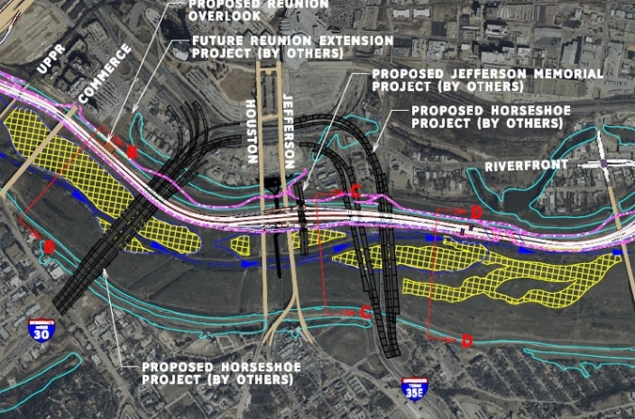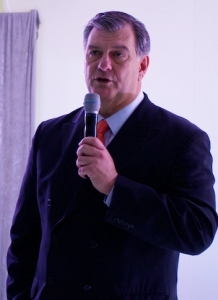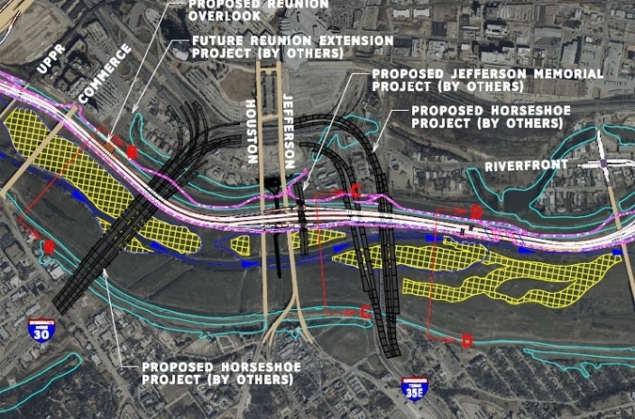
Jason already remarked on the interview given by Mike Rawlings to the DMN editorial board, as reported by Tod Robberson. The mayor seemed to be testing out his talking points in front of an editorial audience. I don’t think his handlers would have recommended the daily newspaper as the best audience to practice on, but one of the refreshing things about Mayor Mike is that he seems to pay little attention to his handlers.
He says he has spent months trying to understand the issues, and I believe him. He is a conscientious man. Moreover, it is quite clear that he has studied others’ opinions on the subject in order to understand them. (“I love contrarian points of view,” he says.) His stronger statements come across poorly in print, but in the recording of the interview the mayor’s tone is reasonable and respectful.
I have always considered it part of my job to straighten the ties and brush off the lint for mayors before they wander out in public, so in that spirit I will unpack a few of the mayor’s assertions to see how well they will fare in the upcoming public debate.
Assertion #1:
He is committed to the tollway (“more committed than ever”) because it represents an opportunity for southern Dallas residents. He wants to ensure “economic parity” between north and south. This is the key point for him. Dallas now ranks number one in family poverty among cities in the U.S., primarily due to the large number of single mothers. We must do what we can to help them. The tollway is one such thing.
Unpack: The major reason poor people stay poor is that transportation costs eat up a proportionately large portion of their income. Surely the mayor is aware of the many studies that show how every dollar of added transportation costs forces the working poor further behind.
If the goal is to help poor people to reach their jobs, a tollway is a strange way to do it. A one dollar one-way toll would cost the commuter $480 a year. To a single mother earning, say, $12 an hour (an annual take-home pay of $20,460), $480 is a significant, almost insurmountable, amount of money.
Even if he builds the tollway for that working single mother, she will not use it. She cannot afford to. The people Rawlings claims to want to help are the very people a tollway – of all things – is least likely to help because they cannot afford to use it.
That’s from the perspective of the working poor. From a citywide economic perspective, there are 77,412 employees in the two zip codes, 75235 and 75247, that make up the Stemmons Corridor, from the medical district to Love Field, which the mayor says is the focus of his attention.
How many of those commute from southern Dallas? The mayor does not say. Maybe he does not know. Should we estimate 10,000? 50,000? 5,000? Southern Dallas makes up 28 percent of the population; so let’s say 28 percent of total employment in that area is from southern Dallas. That would be 21,700 people.
The mayor says he likes numbers. By what metric does it make sense to spend $1.5 billion to make the commute a little faster for the tiny percentage of 21,700 people who will be able to afford the toll?
While we ponder that question, let’s move on to another: if the people from southern Dallas won’t be using the tollway, who will?
Assertion #2.
Rawlings states that “…that 67 percent of travelers on the corridor heading north from southern Dallas are coming to jobs in Dallas, and that 45 percent are citizens of Dallas.”
Unpack. If 45 percent of travelers are citizens of Dallas, 55 percent of travelers are not citizens of Dallas. So drivers who are not taxpayers of Dallas cause most of the congestion that Rawlings wants to relieve by building a tollway. He wants the NTTA to spend $1.5 billion more to make the commutes of these drivers easier.
Again, the mayor says he likes numbers. That 55 percent is a big number. It should tell him a great deal about what is wrong with the thinking that caused us to be number one in family poverty in the nation. In the 1960s and 1970s we built an entire road system that the mayor’s own data show mainly serves people who are not Dallas taxpayers. That was a gigantic mistake, and studies show that much of our present poverty can be traced it. The trend continues downward. Median household income in Dallas has dropped $10,000 in ten years.
Yet the mayor wants to build another road, presumably to relieve the congestion caused by all the people who don’t live here who have filled up the other roads. There must be some logic in this somewhere, but I cannot find it.

Assertion #3.
A poll of residents show congestion is growing worse. In 2011, 55 percent of southern Dallas commuters expressed satisfaction. Today, that number has dropped 8 percentage points – as anyone in marketing knows, the mayor says, that is huge.
Unpack. According to Texas Transportation Institute, DFW averaged 13.26 miles driven per person per day in 2006. That number has since fallen to 11.90. Perception may or may not be reality, but perception is all a poll measures.
But if congestion has increased – and that is a big if — I propose a simpler solution than a $1.5 billion tollroad. Send the 55 percent of drivers who do not pay taxes in Dallas – especially, those of them that are truckers – around the city, instead letting them run through it. If 55 percent of the traffic no longer comes through the city, you have solved the congestion problem. Our southern Dallas single mother could speed to work at Parkland without having to pay another dime.
Assertion #4
He characterizes opponents to the tollway as (1) conspiracy theorists who think rich people are scheming to profit off of it, (2) people who believe economic development will come from tearing down highways, although “I buy 90 percent of what they say” but the idea “that jobs will come to southern Dallas is just not going to happen,” and (3) people who do not respect democracy. The mayor says that what the voters voted on in 1998 and 2007 has not changed.
Unpack. I’ll address (1) and (3) because we have already made the economic development argument in print and online, and I am sure the mayor has studied it, so I don’t want to bore him by repeating it.
About the conspiracy types he is absolutely correct, but I would have thought we all we have gotten accustomed to them by now. The irony is, most developers I know fervently hope that the tollway will go away. Instead of being a conspiracy by rich people, the tollway more and more looks to be a conspiracy against rich people, if rich people are the investment pools and pension funds who are backing the new developments in West Dallas, Oak Cliff, and near-downtown and creating new taxable value for Dallas that the tollway may in some cases obliterate.
And that brings me to the democracy argument. In any democratic order – even in Robert’s Rules of Order – a person who has voted for a proposition is the person allowed to bring it back up for consideration. I am one of those long time supporters of the tollway who has changed his mind, largely based on what I see happening in front of me. The city has changed dramatically since 1998 and even since 2007. Trinity Groves, the Design District, the Cedars, Farmers Market are all expressions of that change. This is a city that wants to build its urban core. The tollway is old thinking, based on nearly 20-year-old assumptions about a city that no longer exists. If the tollway has not changed, the city has. So yes, based on new evidence there for anyone to see, I vote to reopen the issue. That is not anti-democracy. That is the essence of democracy.
Assertion #5.
“And the notion is nonsense, he suggested, that jobs will somehow miraculously come to southern Dallas if we tear down I-345 and cancel the tollway.”
Unpack. The mayor has decided to conflate I-345 with the tollway, and I don’t blame him. The more he can do to confuse the issue, the better chance he has concealing the confusion that marks his own argument. For my part, I have not seen, and I certainly have not made, an argument that cancelling the tollway will produce jobs for southern Dallas. I have made the argument that jobs will come to an enlarged downtown Dallas once we reconnect downtown to Deep Ellum and Baylor, and Deep Ellum and Baylor to Fair Park. Uptown and the new urban neighborhoods demonstrate the market pressure that will bring new investment. If the mayor doubts me, he can do what I did, which is to talk to major real estate developers and investors. He says he likes contrarian points of view. I challenge him to seek them out.
We have two needs. One is to create jobs. Dallas County lost 260,000 jobs in the last census. Surely the mayor is aware of that. Development creates jobs. The second need is to create jobs closer to the working poor, so we can reduce – not add to — their transportation costs. The development of the area under I-345 will do just that. Yet the mayor seems now to be opposed to doing anything about I-345. Is it because it will not produce jobs miraculously? I would hope he would be content with the market producing jobs naturally and organically. That is what happens when you have a strong demographic movement to your city core and you remove artificial barriers to growth like I-345 and I-30.
The mayor even goes so far as to say my position “smacks of segregation.” To the contrary. The elevated highways divided this city, destroyed East Dallas, cut off downtown, leveled a thriving South Dallas, turned Fair Park into a land of concrete and parking lots, and put poor people into a zone isolated by the interstates. The mayor wants to keep all that, for reasons I cannot fathom. The mayor thinks he is the good guy, he is fighting the righteous fight, he is for the poor. But he is upholding a status quo that has brought 40 years of blight and economic degradation, not to mention racial division, to our city. Just whose position “smacks of segregation” is a question I think the mayor should carefully reconsider.
Assertion #6.
The mayor says “a beautiful park is very important to me.” He intends to put aesthetic considerations at the top of the list. He has tried looking at the plans, but they are confusing to look at. Once he gets the final rendering, if the thing is not beautiful, he will drop it.
Unpack. I am very glad to hear he cares about beauty. More people should. But later he says that once this is turned over to the NTTA the city will have nothing to do with it. So I wonder just how he intends to enforce the aesthetic standards he is so concerned about.
Assertion #7
As to timing, he expects the Federal Highway Administration and the Corps of Engineers to sign off on the project in the first and the last parts of March, respectively. Asked if he expected the NTTA to accept the project soon, he said he has received no assurances as to timing. Asked again if he thinks the NTTA will act before the May City Council elections, he said yes.
Unpack. The mayor is pushing as hard as he can to get the project approved and signed over to the NTTA before the city’s support can be reversed in the election. And – whoosh! – just like that, the paeans to democracy he was singing a few minutes before come to an abrupt halt.
Conclusion:
For Mike Rawlings, the tollway is now an article of faith, not a prudential choice. The mayor believes in spite of the evidence, not because of it. He knows his intentions are good, and that seems to be all he needs to know. Because his intentions are good, others’ intentions must be bad. He has not spent his time listening to opponents, he has spent it honing what arguments he has against them. He cares about poverty but his notions will only perpetuate it. He claims a duty to the whole of the city, but plays the race card as carelessly as flinging a lighted match into a pool of gasoline.
The mayor may not have intended his rhetoric to be so inflammatory. After all, it is obvious that he is still testing phrases fed him by his campaign people at Allyn Media. (The line about opponents believing “gridlock is good and highways are inherently bad” — if it can be delivered with a straight face — is an obvious product of the focus groups.) Nevertheless, these seem to be the main assertions that he will roll out over the next few months. And, as he says, the key one is that we need a tollway to help southern Dallas people get to their jobs faster.
He has invented that new reason for the tollway out of whole cloth. It was never brought up in 1998 or in 2007. Like other reasons for the tollway that have gone by the wayside, this latest one is not very convincing, especially as pertains to the working poor.
But he will go with it anyway. He says that “the more I study it, the firmer my feet get in the concrete …” It is an awkward metaphor. It may also be an accurate one.






